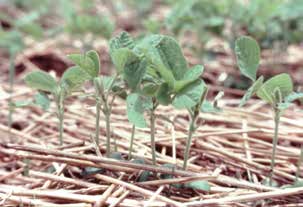chAPter 14 reduCing erosion and runoFF
upslope areas expose subsoil and may in many cases
further aggravate runoff and erosion. We discuss tillage
practices further in chapter 16.
Significance of Plant Residues and Competing Uses
Reduced-tillage and no-tillage practices result in less
soil disturbance and leave significant quantities of crop
residue on the surface. Surface residues are important
because they intercept raindrops and can slow down
water running over the surface. The amount of residue
on the surface may be less than 5% for the moldboard
plow, while continuous no-till planting may leave 90%
Figure 14.3. Soybeans grown under no-till with corn residue.
or more of the surface covered by crop residues. Other
Reduced Tillage
reduced-tillage systems, such as chiseling and disking
Transition to tillage systems that increase surface cover
(as a primary tillage operation), typically leave more
and reduce disturbance is probably the single most
than 30% of the surface covered by crop residues.
effective and economical approach to reducing ero-
Research has shown that 100% soil cover virtually elimi-
sion. Restricted and no-till regimes succeed in many
nates runoff and erosion on most agricultural lands.
cropping systems by providing better economic returns
Even 30% soil cover reduces erosion by 70%.
than conventional tillage, while also providing excellent
As discussed in chapter 9, there are many competing
runoff and erosion control. Maintaining residues on the
uses for crop residues as fuel sources, as well as building
soil surface (figure 14.3) and eliminating the problem
materials. Unfortunately, permanent removal of large
of soil loosening by tillage greatly reduce dispersion of
quantities of crop residues will have a detrimental effect
surface aggregates by raindrops and runoff waters. The
on soil health and the soil’s ability to withstand water
effects of wind on surface soil are also greatly reduced by
and wind erosion.
leaving crop stubble on untilled soil and anchoring the
soil with roots. These measures facilitate infiltration of
Cover Crops
precipitation where it falls, thereby reducing runoff and
Cover crops result in decreased erosion and increased
increasing plant water availability.
water infiltration in a number of ways. They add organic
In cases where tillage is necessary, reducing its
residues to the soil and help maintain soil aggregation
intensity and leaving some residue on the surface mini-
and levels of organic matter. Cover crops frequently
mizes the loss of soil organic matter and aggregation.
can be grown during seasons when the soil is especially
Leaving a rougher soil surface by eliminating second-
susceptible to erosion, such as the winter and early
ary tillage passes and packers that crush natural soil
spring in temperate climates, or early dry seasons in
aggregates may significantly reduce runoff and erosion
semiarid climates. Their roots help to bind soil and hold
losses by preventing surface sealing after intense rain
it in place. Because raindrops lose most of their energy
(see figure 6.9, p. 63). Reducing or eliminating till-
when they hit leaves and drip to the ground, less soil
age also diminishes tillage erosion and keeps soil from
crusting occurs. Cover crops are especially effective in
being moved downhill. The gradual losses of soil from
reducing erosion if they are cut and mulched, rather
156
Building SoilS for Better CropS: SuStainaBle Soil ManageMent







